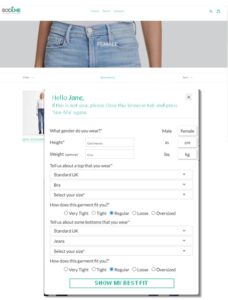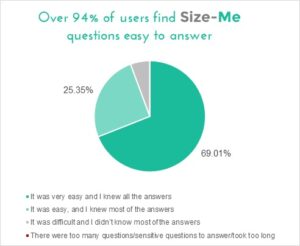The headlines are awash with stories about ChatGPT and AI. Indeed, ChatGPT has, in many ways, taken the world by storm since its launch to the public on 4 December 2022. Just eight weeks later, it had more than 100 million registered users.
ChatGPT is a chatbot that integrates two kinds of AI models: a language AI model (for speech recognition and translation), and another ‘reasoning AI’ model that overlays existing knowledge. But how smart is it really?
Bodi.Me’s Size-Me size recommendation tool uses cutting-edge machine learning, which is a branch of AI, combined with our extensive database and proprietary technology, to determine a wearer’s perfect fit from a few simple data points with remarkable accuracy. Our latest iteration, Size-Me 3.0, has enhanced ‘fit’ preferences for granular accuracy. But what data do you really need to accurately predict someone’s perfect fit in any given fashion brand or uniform range? We asked ChatGPT if you can get an accurate size and fit prediction from just a person’s height and weight. Here is its answer (TL;DR “No”).
“It is not possible to determine a person’s trouser waist measurement based solely on their height and weight. The waist measurement is influenced by a variety of factors, including body shape, muscle mass, and the fit of the trousers.
“If you know that a person’s waist measurement is 34 inches, you can use this information to determine their trouser size.
“In general, trouser sizes are determined by the waist measurement in inches. A waist measurement of 34 inches would typically correspond to a trouser size of around 34 or 36, depending on the brand and the fit of the trousers.
“However, it’s important to keep in mind that trouser sizing can vary between brands and styles, so it’s always a good idea to check the specific sizing chart for the brand you are interested in. Additionally, other measurements such as inseam length and hip circumference may also be important when selecting the right size and fit for a particular individual.
“If a person is 185cm tall, weighs 84 kg, and has a waist measurement of 28 inches, it is likely that there has been a mistake in the reported waist measurement. A waist measurement of 28 inches (71cm) would be very small for a person who is 185cm tall and weighs 84 kg, and it would be unlikely for them to wear trousers with such a small waist size.
“In general, a person’s waist size is typically proportional to their height and weight, and it can vary based on factors such as body shape and muscle mass. It’s important to have an accurate measurement of the waist in order to select the correct trouser size, so it may be a good idea to double-check the reported measurement or have the person measure their waist again to ensure accuracy.”
That rather long-winded response agrees with what we have determined at Bodi.Me – that height and weight alone are not useful measurements to determine fit. It is why, unlike many other size recommendation tools, Size.Me does not rely on these two data points. It is also why, in the new version 3.0, we have added more layers of granularity to finetune Size-Me’s accuracy even further.

As ChatGPT points out, fit is variable in fashion and even uniforms. From one brand to another, one person can wear different sizes. Then there’s personal preference – we are all individuals, and we have individual preferences when it comes to fit. Size-Me 3.0 takes account of this for both our retail and uniform clients by asking wearers about the clothes they wear and how they fit rather than simply requesting time-consuming and potentially sensitive measurements.
And this approach works. The industry average returns rate is 45%. For customers using Size-Me, this drops to less than 6%. That’s huge.

“This extraordinary level of returns is down to the accuracy and user-friendliness of Size-Me as well as the high degree of customisation the platform is capable of,” says Lara Mazzoni, CEO and co-founder of Bodi.Me. “We are proud that our customer data proves that we are exceeding in our goals of 50% reduction in returns.”
The user-friendliness of the system is important. If shoppers don’t engage with a size recommendation tool, whether because it is too intrusive, too complicated or too time-consuming, it doesn’t matter how good it is. It won’t do the job if people won’t use it.
We recently conducted a survey of end users of Size-Me – the wearers themselves – and more than 94% said they found the tool’s questions easy to answer. This leads to high levels of engagement. Almost 70% engage with the tool – the average for size and fit tools is just 27%. This is one of the reasons Size-Me is so successful in reducing returns. And fewer returns mean higher profits, a lower carbon footprint, fewer garments to landfill, and the data to optimise collections to avoid overstock and maximise sell-through in the future.

“Our goal is to constantly upgrade our solution to increase ROI for our clients by leading in accuracy as well as customer adoption,” says Lara. “Our recent clients have over a tenfold return on their investment from implementing Size.Me.”

